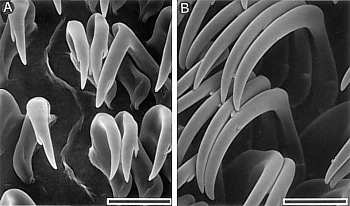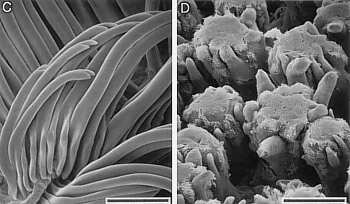

Rostanga elandsia
- Radula
PHOTO
(A) inner lateral teeth, scale = 25 µm, (B) mid-lateral teeth, scale = 30 µm, (C) outer lateral teeth, scale = 43 µm, (D) caryophyllida, scale = 75 µm. PHOTOS: Darrel Ubick
The labial cuticle is smooth, with no jaws. Radular formula 49 x 60.0.60 (preserved 13 mm spm), 54 x 78.0.78 (preserved 20 mm spm). The inner lateral teeth are thin, hook-shaped, and have one denticle on the outer side of the primary cusp (A). The change in size from the inner to mid-lateral teeth is gradual. The mid-lateral teeth have a single, very small denticle on the inner side of the cusp (B). Both the base and the cusp of each mid-lateral tooth is long and slender. The outer lateral teeth are elongate and thin, with a single, blunt denticle at the end (C). The teeth gradually decrease in size from mid to outer laterals. The outermost lateral teeth are not much smaller than the other outer lateral teeth.
Rostanga bifurcata, R. dentacus, R. rubra and R. risbeci are the only species that have the outermost lateral teeth with a single denticle. All of them differ from Rostanga elandsia in having jaws and wider innermost lateral teeth with several denticles on the inner side of the central cusp. These species also have much longer outer lateral teeth and the denticle on the outer lateral teeth is much longer and sharper than in R. elandsia
Reference:
• Garovoy, J.B., Valdés, A. & Gosliner, T.M. (2001). Phylogeny of the genus Rostanga (Nudibranchia), with descriptions of the three new species from South Africa. Journal of Molluscan Studies 67(2), 131-144.
Rudman, W.B., 2002 (February 15) Rostanga elandsia - Radula. [In] Sea Slug Forum. Australian Museum, Sydney. Available from http://www.seaslugforum.net/factsheet/rostelanrad
